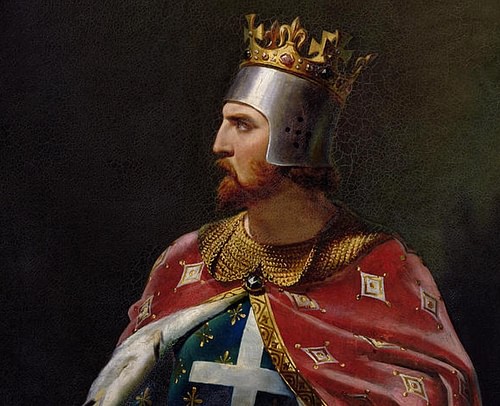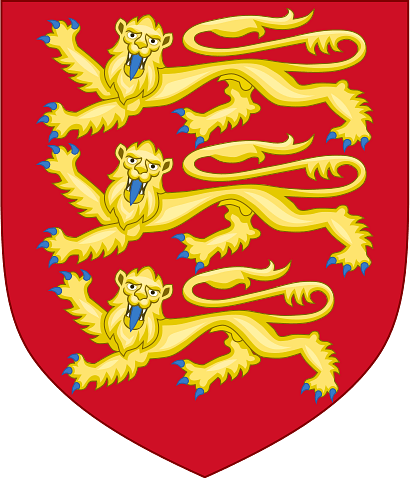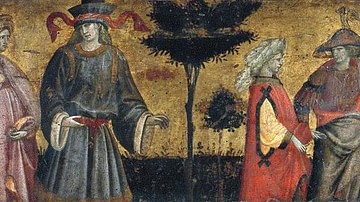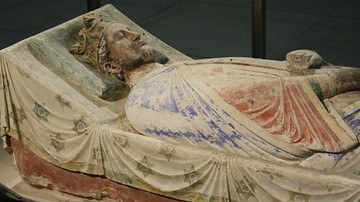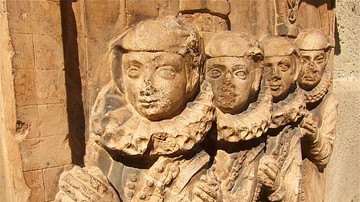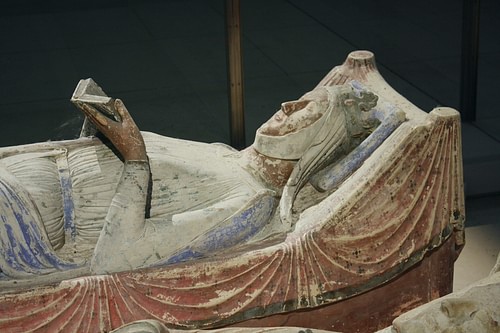
Eleanor of Aquitaine (l. c. 1122-1204 CE) was one of the most impressive and powerful figures of the High Middle Ages (1000-1300 CE) – male or female – whose influence shaped the politics, art, medieval literature, and perception of women in her era.
She was the Duchess of Aquitaine, a province of France, from 1137-1204 CE, Queen of France (1137-1152 CE), and Queen of England (1154-1189 CE). After 1189 CE, she continued to wield considerable political and social power in arranging marriages for her grandchildren.
She was the wife of Louis VII of France (r. 1137-1180 CE) with whom she had two daughters, Marie de Champagne (l. 1145-1198 CE) and Alix of France (l. 1150-1197 CE). This marriage was annulled on the grounds of consanguinity (Eleanor and Louis were third cousins) in 1152 CE, and she quickly married Henry II of England (r. 1154-1189 CE) with whom she had eight children. Among these were Richard I of England (r. 1189-1199 CE) and King John (r. 1199-1216 CE) of Magna Carta fame as well as Eleanor of England (l. c. 1161-1214 CE), mother of Blanche of Castille (l. 1188-1252 CE).
A great patroness of the arts (as most of her children and grandchildren would be), she inspired the works of Bernard de Ventadour (12th century CE), Marie de France (wrote c.1160-1215 CE), and other influential Provencal poets. Her daughter Marie would be patroness to Andreas Cappellanus and Chretien de Troyes, one of the most influential poets of Courtly Love and the Arthurian Legend.
Eleanor's influence defined her time not only in the regions she governed but in those she came in contact with. She served as a role model for a number of upper-class women, and her legacy was continued by her children and grandchildren, most notably in the case of Eleanor of England and Blanche of Castille. Her interest in the literary arts and patronage of them produced the most interesting and popular genre of the day – Provencal romantic poetry – a body of work which influenced the aristocracy's perception of women and continues to inspire artistic expression in the present day.
Early Life & Rise to Power
Eleanor was born in 1122 CE to William X, Duke of Aquitaine (l. 1099-1137 CE) and Aenor de Chatellerault (l. 1103-1130 CE). Her name (Alienor) means “the other Aenor”, and she may be the first woman to carry this name and so the first “Eleanor”. Her grandfather was the famous troubadour and warrior William IX (l. 1071-1127 CE) whose works influenced the development of later Provencal romantic poetry. William X, though lacking the poetic skills of his father, inherited his love for literature. He encouraged Eleanor and her younger sister Petronilla in education and cultural refinement. As a young girl, Eleanor was fluent in Latin and adept at all the sports of kings such as hunting and hawking. Her mother saw to her education in domestic affairs such as spinning, weaving, and keeping household accounts.
In 1130 CE, her mother and younger brother Aigret died, and her father died seven years later of dysentery while on pilgrimage in April 1137 CE. William X understood completely the kind of danger he was leaving his eldest daughter in. Aquitaine was an enormous fiefdom spreading “from the river Loire to the foothills of the Pyrenees, from the central heights of Auvergne to the western ocean…wider and fairer than that of the King of France himself” (Kelly, 4). In a time when noble women – especially heiresses to a patrimony such as Aquitaine – were kidnapped regularly to gain their land, William X knew he had to act quickly to protect Eleanor and her inheritance.
While dying, he instructed his courtiers to go quickly to King Louis VI of France (r. 1108-1137 CE, also known as Louis the Fat) and petition him to grant protection to Eleanor until a suitable match could be made for her. Louis was also asked to provide that match by finding her a good husband. Once Louis received the news, he lost no time in arranging a marriage between his son and Eleanor; they were married three months later.
Queen of France & the Second Crusade
Louis VII was never meant to be king. He had been groomed for the clergy from a young age but the death of his older brother Philip, the heir apparent, in 1131 CE altered the plan. Louis was heir to the throne but lacked the training and experience which went into grooming a future monarch. Further, he had led a sheltered life, having spent most of his time in monasteries, and had little experience in travel. Eleanor, on the other hand, had frequently traveled with her father throughout Aquitaine and had most likely heard the tales of her grandfather's adventures in the Crusade of 1101 CE. Eleanor was flamboyant, worldly, and not at all shy in expressing her desires; Louis was quiet, submissive, and seemingly in awe of his wife.
When Louis accepted the charge to lead the Second Crusade to the Holy Land, Eleanor made clear she would be going as well. Louis' goal in funding and leading the expedition was to do penance for the massacre of the citizens of the town of Vitry in his war with the Count of Champagne; Eleanor's sole intention seems to have been to go on a grand adventure. Louis had little experience in leadership and none in travel or logistics and so, unsurprisingly, the crusade did not go well. Eleanor was routinely criticized by medieval historians for behaving as though she were going to a party or palace ball. She brought along 300 ladies-in-waiting and a baggage train allegedly miles long to carry all their dresses and other necessities. Even so, these same historians make clear she was a more able leader than her husband and more respected by the troops.
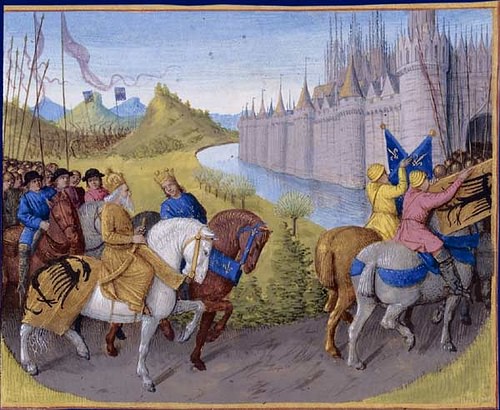
In Laodicea (Asia Minor), as the party made their way over Mount Cadmus en route to Antioch (where Eleanor's uncle, Raymond of Poitiers was expecting them), Eleanor encouraged the vanguard where she was riding to press on while Louis, bringing up the rear, had given orders for the column to stop and rest for the night. The column therefore separated and the Turks, who had been watching, ambushed the rear guard, massacring them. Louis only escaped because he was dressed as a cleric and managed to hide in a tree. Once in Antioch, Eleanor took center stage and Louis appears as one of her servants, not as king. Raymond and Eleanor held conversations at length which Louis was no part of, and Raymond consistently pressured Louis to abandon his goal of reaching Jerusalem to do penance to stay and fight with him to conquer Aleppo.
Whatever initial admiration Louis had for Eleanor was steadily replaced by resentment, and when she suggested an annulment on the grounds of consanguinity, although he initially refused, he consented. After further misadventures in Palestine, the couple returned to France where the marriage was annulled in 1152 CE.
Queen of England & Patroness of Arts
Eleanor married Henry, then Duke of Normandy, only weeks after the annulment. Henry became king of England in 1154 CE and Eleanor his queen, but she was not able to dominate Henry as easily as she had Louis. Their marriage was a series of battles as Eleanor tried to control her husband and he resisted through countless affairs. Henry's famous temper and impulsive nature did nothing to help the relationship, and his transparency regarding his affair with the noblewoman Rosamund Clifford seemed designed to humiliate his queen.
Eleanor did not help the situation by surrounding herself with poets and artists and ignoring Henry's tantrums as often as possible. She may have also had an affair with Bernard de Ventadour (lived at court 1152-1155 CE). Generally speaking, Eleanor endured her marriage in typical fashion by channeling her energies elsewhere and raising her children, through whom she knew she could eventually wield greater power and influence than Henry through advantageous matches with foreign nobility.
C. 1170 CE, Eleanor separated from Henry and moved to her ancestral lands in Poitiers. Here, as she had done earlier in France when she was married to Louis and again in England, she filled her court with poets and artists. Eleanor's favorite son, Richard, came with her and her daughter from her first marriage, Marie, was also there (although scholars continue to debate Marie's presence in Poitiers). Eleanor heard grievances, addressed administrative matters, and entertained guests in the same citadel where her grandfather, the great troubadour, had done the same. Scholar Amy Kelly writes, “the queen and the countess [Marie], with their native poetic tradition, were the natural patrons of the troubadours” (161). This period at Poitiers is the one scrutinized most often by literary historians because of Eleanor's influence on the development of the concept of courtly love and chivalric poetry.
The type of verse now known as courtly love poetry or chivalric poetry was nothing new to the 12th century CE but the poets at Eleanor's court at Poitiers or Marie's court at Troyes were refining the genre and developing more intricate characterizations which, some scholars claim, were advances encouraged by Eleanor and Marie. According to the poet Andreas Capellanus (who wrote for Marie), Eleanor, Marie, and other high-born ladies would hold courts of love in which they would discuss such questions as whether true love could exist in marriage (it could not), what constituted love (devotion of the lover to the beloved), and other such matters. Scholars have consistently questioned whether these courts really took place or were simply a literary invention but, one or the other, the poetry produced after Eleanor's time at Poitiers is developed to a greater depth than previously and deals with the same themes and questions Capellanus references.
Some scholars have also advanced the theory that the courtly love poems were allegories for the heretical beliefs of the Cathars, a religious movement regularly persecuted by the Church at the time. The Cathars (“pure ones”) believed that they, not the church, knew the divine truth and venerated a female deity Sophia (“wisdom”). According to some scholars, the well-known motif of the damsel-in-distress who must be rescued by the brave knight is a symbolic representation of the goddess Sophia, persecuted by the Church, who must be protected by the Cathars.
Eleanor and Marie both had disagreements and clashes with the Church and were suspected of sympathizing with the Cathars, so it may be they were involved in encoding Cathar belief in verse, but this theory is far from universally accepted. It would hardly be surprising if they did, however, as the Cathari belief system, which did not discriminate between the sexes and consistently criticized the hypocrisy and violence of the Church, would have appealed to both women.
Revolt & Imprisonment
In 1173 CE, Eleanor and Henry's oldest son, Henry the Young King (1155-1183 CE), rebelled against his father. The revolt, incited by nobles who stirred up young Henry's resentment toward his father, lasted eighteen months and cost many lives before it was finally crushed. A young Sir William Marshal (l. 1146-1219 CE), the greatest knight of the period, was involved on the side of Henry the Young King, Richard the Lionheart, and Geoffrey Plantagenet. Marshall had been young Henry's tutor in arms and was devoted to the queen and her sons, so his involvement supports the claim made by some historians and scholars that it was Eleanor who instigated the revolt.
Whether she did or not, she openly supported her sons and, after the revolt was put down in 1174 CE, Henry had Eleanor abducted in France and imprisoned in England. For the next 16 years, Eleanor would be moved between Henry's various strongholds until his death in 1189 CE. By this time, Henry the Young King had died of dysentery and Richard I became king. Eleanor knew she could enact her own policies through Richard without the kind of constant resistance she had met with from Henry II. She would have a much freer hand than she anticipated, however, as Richard left England to take part in the Third Crusade the following year and seems to have gladly left Eleanor in charge of his kingdom.
Regent of England
Although nominally the regent, Eleanor signed herself, and had others address her, as “Eleanor, by the grace of God, Queen of England” (Kelly, 288). She ably picked up her political maneuverings as though she had not been confined for the past 16 years. Kelly writes:
In her long restraint, with only philosophy for her exercise, she had, it seemed, accumulated wisdom and somehow kept pace with the progress of history. She had attained Henry's capacity for bold maneuver, but she was more folk-wise than he, more sensitive to popular drifts, and more ingenious in taking advantage of these. (288)
She understood that the crusades in a far-off land for a nebulous cause were a waste of her energies and channeled her efforts into regaining the kingdom's balance which had been lost following Henry II's death and Richard I's departure for the Holy Land. The kingdom had been facing difficulties for decades, though, due largely to her late husband's acrimonious relationship with her first husband, Louis VII. Louis had died in 1180 CE, and his son by his second marriage, Philip II (known as Philip Augustus, r. 1180-1223 CE), was king.
Philip had also gone on the Third Crusade and fought alongside Richard at Acre, but the two had quarreled over a number of issues, including land rights, and parted on poor terms. Philip returned from the Crusades but Richard was kidnapped in 1192 CE and held for ransom by Henry VI of the Holy Roman Empire.
Philip initiated a number of campaigns to reclaim land lost to the Plantagenets and extend his power while also entering into secret negotiations with Eleanor's youngest son John, who was anxious to get rid of his older brother and become king. Eleanor kept the nobles of England loyal to Richard while raising his ransom, which she then delivered herself to Austria and brought her son home in 1194 CE. Richard would only reign for another five years before he was killed in battle in 1199 CE.
Conclusion
John then succeeded to the throne and, in May 1200 CE, concluded a peace treaty with Philip Augustus which had to be sealed through marriage between the French house of Capet and the English house of Plantagenet. Eleanor traveled to Castille, where her daughter Eleanor reigned, and brought back her granddaughter Blanche of Castille to marry Philip's son, Louis VIII (also known as Louis the Lion, l. 1187-1226 CE). This last act done, Eleanor retired to Fontevraud Abbey. She died there, of natural causes, in 1204 CE. The peace she had helped broker between England and France through Blanche's wedding had already been broken by the time of her death, and John's early reign is characterized by a series of diplomatic mistakes Eleanor would never have made which encouraged the conflict between France and England.
These conflicts finally led to the full-scale engagement of the Anglo-French War (1213-1214 CE) in which John's forces were defeated by those of Philip II. England lost most of its lands on the continent and the Angevin Empire forged by Henry II and Eleanor collapsed. Eleanor's influence continued to be felt, however, through strong, independent women such as her granddaughter Blanche de Castille. Whether as a role model or through the poetry she inspired, Eleanor's impact continued long after her death.


